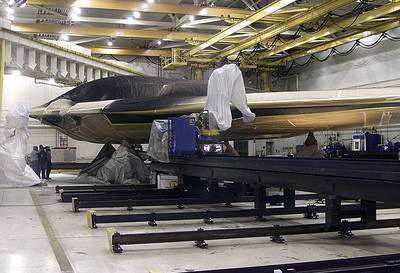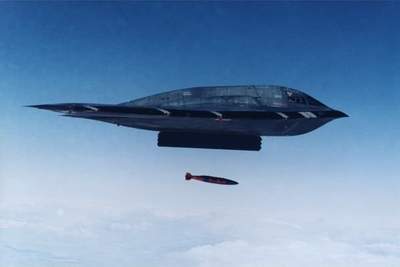New Application Makes Spirit Stealthier
Northrop Grumman Corporation has successfully applied a
specially formulated coating developed to help improve the B-2
stealth bomber's combat readiness to an operational aircraft for
the first time. The coating was applied at the company's Antelope
Valley Manufacturing Center using a robotic paint system.

Known as alternate high-frequency material (AHFM), the
radar-absorbing coating was developed by Northrop Grumman's
Integrated Systems sector, the B-2 prime contractor, for
application to the aircraft surface in areas where regular
maintenance is performed. The B-2's stealth characteristics require
a smooth outer surface without any gaps that could reflect radar
waves and reveal its position to the enemy.
The original B-2 design called for specially formulated tapes
and caulks to cover gaps on the surface such as those near
maintenance access panels.Those special materials must be removed
each time maintenance is performed, then reapplied and allowed to
cure before the aircraft can be returned to service. AHFM replaces
approximately 3,000 feet of tape, which helps reduce maintenance
time in those areas from several days to several hours.
"The development of AHFM is another example of how Northrop
Grumman is working with the Air Force to ensure that the B-2
remains as effective in combat tomorrow as it is today," said Duke
Dufresne, Northrop Grumman vice president and B-2 program manager.
"It's one of several ways we're improving the weapon system with
the latest technologies so it can continue to play an important
role in the military's emerging integrated battlespace."
To ensure a precise, uniform application of the material,
Northrop Grumman developed an automated system consisting of four
independently controlled robots.
"Each robot is preprogrammed to paint one of the AHFM
application areas on the aircraft," said Michael O'Keefe, manager
of automation at the Palmdale facility. "This system can precisely
apply the AHFM in the correct thickness, which is measured in
thousandths of an inch."
The AHFM-equipped aircraft is expected to be delivered to the
Air Force later this year at the end of its current airframe
maintenance period. Airframe maintenance is regularly performed by
Northrop Grumman in Palmdale on B-2's that arrive from their
operational home at Whiteman Air Force Base (MO).

The B-2's unique capabilities allow it to penetrate an enemy's
most sophisticated defenses and threaten its most valued and
heavily defended targets. The B-2 meets the Air Force's requirement
for long-range, lethal and survivable systems to project air power
anywhere in the world. It can fly more than 6,000 nautical miles
unrefueled and more than 10,000 nautical miles with just one aerial
refueling, giving it the ability to fly to any point on the globe
within hours.
Northrop Grumman and the Air Force are working on a series
of enhancements to the B-2's ability to respond to emerging
worldwide threats as a key element of the military's
network-centric warfare concept. For example, some of these
improvements will make the B-2 better equipped to communicate and
exchange data with joint force commanders and receive updated
target information during a mission. In addition, integration of a
new electronically scanned array radar antenna will modernize the
onboard radar system.
The improvements also include a "smart-bomb rack assembly"
that will give the B-2 the ability to deliver 80 "smart"
(GPS-guided) weapons on a single pass, five times as many as its
current capacity. Successfully tested on a B-2 last year, the new
bomb rack is scheduled to be operational in 2004. Last year's test
with inert 500-pound Joint Direct Attack Munitions (JDAM) marked
the first time an aircraft has delivered that many guided,
independently targeted weapons at one time. Northrop Grumman
managed the development of the smart-bomb rack with its major
subcontractor, The Boeing Co.
Northrop Grumman Integrated Systems is a premier aerospace
and defense systems integration enterprise. Headquartered in El
Segundo (CA), it designs, develops, produces and supports
network-enabled integrated systems and subsystems for government
and civil customers worldwide. Integrated Systems delivers
best-value solutions, products and services that support military
and homeland defense missions in the areas of intelligence,
surveillance and reconnaissance; space access; battle management
command and control; and integrated strike warfare.
 ANN's Daily Aero-Linx (05.06.25)
ANN's Daily Aero-Linx (05.06.25) ANN's Daily Aero-Term (05.06.25): Ultrahigh Frequency (UHF)
ANN's Daily Aero-Term (05.06.25): Ultrahigh Frequency (UHF) ANN FAQ: Q&A 101
ANN FAQ: Q&A 101 Classic Aero-TV: Virtual Reality Painting--PPG Leverages Technology for Training
Classic Aero-TV: Virtual Reality Painting--PPG Leverages Technology for Training Airborne 05.02.25: Joby Crewed Milestone, Diamond Club, Canadian Pilot Insurance
Airborne 05.02.25: Joby Crewed Milestone, Diamond Club, Canadian Pilot Insurance




